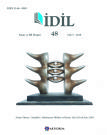THE FIRST VERSE TRANSLATION OF THE STORY OF CÜMCÜME SULTAN
THE FIRST VERSE TRANSLATION OF THE STORY OF CÜMCÜME SULTAN
Author(s): Arzu Çiftoğlu ÇabukSubject(s): Customs / Folklore, Turkish Literature, 13th to 14th Centuries, Translation Studies
Published by: Sanat ve Dil Araştırmaları Enstitüsü
Keywords: Cümcüme Sultan; Hüsam Katib; Golden Horde; Harezm Turkic; prophet Jesus; The Skull;
Summary/Abstract: Legends are very old stories or sets of stories from ancient times, or the stories, not always true, that people tell about a famous event or person but they contribute to the folklore with verbal and written material. Some myths are found not only in their written period and in the region, but also in the following centuries in different geographies with some changes. Thus, it is possible to trace the traces of various cultures through these myths that each society shapes itself. The story of the Cümcüme Sultan, written by Hüsam Katib who is one of the most influential poets of the Golden Horne of the Tatar literature in the fourteenth century and various variants of which were written in the following centuries, is such a fascinating legend. In this story, the adventures of a skull that once belonged to a man who, because of his disbelief in the prophet Elijas when he was a sultan in this world, went to hell are told. But he was resurrected by the prophet Jesus with God’s willing due to his generosity, patronage of the poor and not showing favouritism among people. The message to be given here is knowing that life is mortal. The two oldest texts of the story of Cümcüme Sultan which had religious didactic features, were written by Harezm Turkic, in Hijri 770 (1368) and in Hijri 777 (1376). In this study, the second one that Sâhib Giray Khan (son of Hacı Giray Khan) of Crimean Khanate saw among the treasure books and by order of him, was translated to the Ottoman Turkish in 955 will be handled in the context of language and culture. Because the outputs of the study can be used not only in the fields of language and literature, but also in sociology and folklore fields, the study has an interdisciplinary character.
Journal: İdil Sanat ve Dil Dergisi
- Issue Year: 7/2018
- Issue No: 48
- Page Range: 897-908
- Page Count: 12
- Language: Turkish

